
|
|
|
THE 10 MOST CHALLENGING DANISH CLIMBS
Based on updated, detailed data, this list shows the ten most tiring hills on Danish roads. All of them measure 80 meters in height or more and have an average gradient of at least 5. Very few climbs in Denmark have these characteristics.
The climbs are ranked in accordance with a rating system that specifies the degree of difficulty. However, several criteria play a role in the assessment of a climb. Read about criteria and definitions at the bottom of this page.
Probably, there are many different opinions out there about climbs, and this pick is, of course, not the only truth. But Danskebjerge.dk has tried to make the criteria as clear and objective as possible.
1.
|
VANG
Landscape: Bornholm
|
Start
(masl.) |
End
(masl.) |
Vertical meters |
Length
(m) |
Gradient
(average) |
Rating
|
Hill on a
MAP
|
|
3.00
|
94.25
|
91.25
|
1260
|
7.2%
|
201.4
|
|
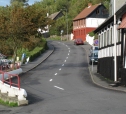
|
Facts about the climb:
The hill begins in the small seaport of Vang. There are some big turns on the way, including a hairpin bend after 200 meters. In the outskirts of Vang, the climb evens out a bit. The top is reached shortly before Borrelyngvej. The climb has a blind start - however, Vang can be reached via paths from the south.
|
A local rider's description:
"This climb is the toughest on Bornholm. People tend to 'boil over' already after that first bend. The average grade is not as extreme as on for example the Helligpeder hill, but it's really long, and the difference in height is considerable. Vang is included in the 'Champion of the Mountains' race on Bornholm, and no doubt the lighter riders have an advantage here." (Ole Karpf, Rønne)
|
|
Estimation
|
Toughness
|
Steepness
|
Aesthetics
|
Ridability
|
Overall
|
MOST DEMANDING!
|

|

|

|

|

|
|
2.
|
JELLINGVEJ
Landscape: Vejle Fjord
|
Start
(masl.) |
End
(masl.) |
Vertical meters |
Length
(m) |
Gradient
(average) |
Rating
|
Hill on a
MAP
|
|
1.50
|
106.00
|
104.50
|
1920
|
5.4%
|
199.3
|
|
Profile at Salite.ch

|
Facts about the climb:
This long hill starts on Valdemarsgade and ends on Petersmindevej (at Stjernevej). But the main part of the stretch lies on Jellingvej, and therefore this road name is the most common name of the hill. The surroundings are rather urban, and you need to pass no less than four crossroads on the ride up.
|
A local rider's description:
"Jellingvej is something quite special. After a long, straight part you arrive at the 'forest line' where the road starts to twist spectacularly. You feel the climb go on and on. Then you cross to the left and approach the final which is the steepest part of the hill, too. Even if you keep a moderate rhythm, you'll feel pretty used up once arriving at the Petersminde School at the top." (Troels Vesterlund, Vejle)
|
|
Estimation
|
Toughness
|
Steepness
|
Aesthetics
|
Ridability
|
Overall
|
TOUGHEST!
|

|

|

|

|

|
|
The Jellingvej hill is part of the Danish medium mountain stage, constructed by Danskebjerge.dk. (Article in Danish)
|
|
3.
|
MUNKEBJERG
Landscape: Vejle Fjord
|
Start
(masl.) |
End
(masl.) |
Vertical meters |
Length
(m) |
Gradient
(average) |
Rating
|
Hill on a
MAP
|
|
3.00
|
92.00
|
89.00
|
1210
|
7.4%
|
198.1
|
|
Profile at Salite.ch
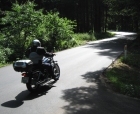
|
Facts about the climb:
Situated on the slope that follows the south side of Vejle Fjord, this hill begins where Ibæk Strandvej breaks right and becomes Munkebjergvej. Early on the hill, you will pass under a railway bridge with traffic lights. You'll primarily go south, but you will be meeting some solid turns on the way. The top is found next to the parking lot of the Munkebjerg Hotel.
|
A local rider's description:
"The presence of history sticks to the asphalt of this wellknown hill. After the famous hairpin turn which makes me quite high on the bike, the light-green beech leaves are succeeded by pine trees, and the final is getting closer: A climb at up to 16 percent grade - here you'll be surprised that even a moderate initial speed will prove costly. - Munkebjerg is a must for all serious bike riders in Denmark." (Troels Vesterlund, Vejle)
|
|
Estimation
|
Toughness
|
Steepness
|
Aesthetics
|
Ridability
|
Overall
|
THE BEST!
|

|

|

|

|

|
|
The Munkebjerg hill is part of the Danish medium mountain stage, constructed by Danskebjerge.dk. (Article in Danish)
|
|
4.
|
HIMMELBJERGET
Landscape: Søhøjlandet
|
Start
(masl.) |
End
(masl.) |
Vertical meters |
Length
(m) |
Gradient
(average) |
Rating
|
Hill on a
MAP
|
|
52.50
|
154.50
|
102.00
|
2010
|
5.1%
|
188.3
|
|

|
Facts about the climb:
The climb is primarily situated on the paved part of Bøgedalsvej. However, the top of the hill is not reached until after a turn to the left along Ny Himmelbjergvej, the road leading to the famous Danish summit Himmelbjerget. Almost all the way, you'll be surrounded by forest (Rye Nørreskov).
|
A local rider's description:
"This is basically one long climb which many bike riders would have used had it not had two dead ends. Bøgedalsvej is almost straight, but small vertical and horisontal bends make it impossible to look more than a few hundred meters ahead. The ascend is moderate on the first 400 meters, after which it gets pretty steep on the rest of Bøgedalsvej - so yet another hill where you must spend your energy wisely." (Ole Thisted, Skanderborg)
|
|
Estimation
|
Toughness
|
Steepness
|
Aesthetics
|
Ridability
|
Overall
|
LONG AND TIRING
|

|

|

|

|

|
|
5.
|
YDING SKOVHØJ
Landscape: Søhøjlandet
|
Start
(masl.) |
End
(masl.) |
Vertical meters |
Length
(m) |
Gradient
(average) |
Rating
|
Hill on a
MAP
|
|
80.00
|
169.00
|
89.00
|
1670
|
5.3%
|
168.1
|
|
Profile at Salite.ch
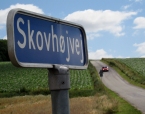
|
Facts about the climb:
This climb lies on Skovhøjvej which - as the name suggests - leads up to Yding Skovhøj, one of the very tallest points in Denmark. The road ascends first towards south-east, later east. At the start, you are surrounded by fields, but about halfways the forest Yding Skov emerges to your left. The top is reached close to Yding Skovhøj. The road conditions are generally fine.
|
A local rider's description:
"A climb which the tour leaders of the bicycle club really fancy. After you've turned off at Ydingvej, it begins to go upwards after two sharp bends. The ascend is steady, until passing Løkkevej where the climbs gets a little steeper. At Hovgårdsvej the road twists a bit - and then goes steeply upwards on the final part."
(Jeannie Outsen, Skanderborg)
|
|
Estimation
|
Toughness
|
Steepness
|
Aesthetics
|
Ridability
|
Overall
|
DENMARK's HIGHEST
|

|

|

|

|

|
|
6.
|
VEJRHØJ
Landscape: Vejrhøj-buen
|
Start
(masl.) |
End
(masl.) |
Vertical meters |
Length
(m) |
Gradient
(average) |
Rating
|
Hill on a
MAP
|
|
12.50
|
99.50
|
87.00
|
1650
|
5.3%
|
165.8
|
|

|
Facts about the climb:
The road starts to go upwards on Dragsmøllevej, after which you'll pass through two crossroads. When on Vejrhøjvej you reach the forest, the toughest part of the hill begins. No need to fear really steep sections, though. Last stop is at the farm Vejrhøjgård. Here, the road ends. A path goes on to the brial mound on the top.
|
A local rider's description:
"The hill is really tiring, but still steep enough to make your pulse go all the way into the red zone. In return, you get a fantastic view, both on the way up and down. The climb has good asphalt. However, there are three speed bumps, and that's a disadvantage." (Per Drews, Fårevejle)
|
|
Estimation
|
Toughness
|
Steepness
|
Aesthetics
|
Ridability
|
Overall
|
TOUGHEST ON ZEALAND
|

|

|

|

|

|
|
7.
|
YPNASTED
Landscape: Bornholm
|
Start
(masl.) |
End
(masl.) |
Vertical meters |
Length
(m) |
Gradient
(average) |
Rating
|
Hill on a
MAP
|
|
4.00
|
87.00
|
83.00
|
1510
|
5.5%
|
159.0
|
|
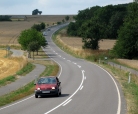
|
Facts about the climb:
This one is situated right between the towns of Svaneke and Gudhjem. It starts blindly down at the water on the small road Ypnasted and continues south to Bølshavn (as on photo). Here, you turn right and go on westward up Randkløvevej until you reach a farm called Søborg. If you omit the first stretch on the small road, the height of the climb is reduced by 23 meters.
|
A local rider's description:
"When there is a race, the field often splits into two on this hill. The fastest will accumulate a good lead here and then give it full throttle as it goes down again right after the peak. - However, this is not my favourite hill. It has no really steep parts, and you can keep a steady speed all the way. Besides, it's a main road with trucks and often some slow-going tourists."
(Ole Karpf, Rønne)
|
|
Estimation
|
Toughness
|
Steepness
|
Aesthetics
|
Ridability
|
Overall
|
BORNHOLM's MOST FAMOUS
|

|

|

|

|

|
|
8.
|
HELLIGPEDER
Landscape: Bornholm
|
Start
(masl.) |
End
(masl.) |
Vertical meters |
Length
(m) |
Gradient
(average) |
Rating
|
Hill on a
MAP
|
|
2.50
|
83.75
|
81.25
|
1490
|
5.5%
|
155.1
|
|

|
Facts about the climb:
The climb begins at the harbour at Helligpeder. You proceed up Helligpedervej and turn left at Borrelyngvej on which you'll reach the top after around 500 meters. The road is relatively narrow at first, and there are a couple of sharp turns. The primary ride direction is east.
|
A local rider's description:
"The hill really goes up from the start: 14 %. Here, you must avoid getting so much lactic acid in your legs that you're down and out when the gradient is reduced a bit further ahead. An "extenuating circumstance" for this tough hill is the fact that you'll often get the west wind from behind. - If you use the road as a descend, you need to be careful. It has occured that a rider has ended up in the ocean."
(Ole Karpf, Rønne)
|
|
Estimation
|
Toughness
|
Steepness
|
Aesthetics
|
Ridability
|
Overall
|
BRUTAL START
|

|

|

|

|

|
|
9.
|
HØJEN SKOVVEJ
Landscape: Vejle Fjord
|
Start
(masl.) |
End
(masl.) |
Vertical meters |
Length
(m) |
Gradient
(average) |
Rating
|
Hill on a
MAP
|
|
5.25
|
89.0
|
83.75
|
1670
|
5.0%
|
153.8
|
|

|
Facts about the climb:
The climb takes off right after you turn from Ribe Landevej on to Højen Skovvej. Then you pass through the forest Højen Skov. When you leave the forest again, the hill gets flatter, and only a few vertical meters remain. Almost all the way, you are moving south.
|
A local rider's description:
"Højen Skovvej goes up and up, at a grade of 12 to 8%, and the very narrow road has similarities to a climb in the Ardennes in a classic cycle race. In fact, Johan Museeuw himself climbed this hill in 2003 and later won the stage to Kolding in the Tour of Denmark. So go for a ride to the Ardennes on Højen Skovvej." (Troels Vesterlund, Vejle)
|
|
Estimation
|
Toughness
|
Steepness
|
Aesthetics
|
Ridability
|
Overall
|
A TITBIT FOR THE EXPERTS
|

|

|

|

|

|
|
|
The Højen Skovvej hill is part of the Danish medium mountain stage, constructed by Danskebjerge.dk. (Article in Danish)
|
10.
|
JENNUMVEJ
Landscape: Vejle Fjord
|
Start
(masl.) |
End
(masl.) |
Vertical meters |
Length
(m) |
Gradient
(average) |
Rating
|
Hill on a
MAP
|
|
15.25
|
95.25
|
80.00
|
1600
|
5.0%
|
146.7
|
|
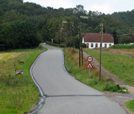
|
Facts about the climb:
The road starts to ascend just outside the village of Skibet which is found right at the valley of Vejle Ådal. At Knabberupvej the slope increases. On the last section of the climb, after a turn to the right at Rugballevej, the gradient of the road is moderate.
|
A local rider's description:
"The hill of Jennum is known as a never-ending hill. It ascends by up to 8 percent at the edge of the wood, and then flattens gradually. For many years the hill has been an ingredient in the race Grejsdalsløbet, forcing a very long ascend upon especially the heavier riders. In the professional stage race Post Danmark Rundt the hill is a more pleasant experience, as it is used as a descend."
(Troels Vesterlund, Vejle)
|
|
Estimation
|
Toughness
|
Steepness
|
Aesthetics
|
Ridability
|
Overall
|
PREFERRED AS DOWNHILL
|

|

|

|

|

|
|
|
The Jennumvej hill is part of the Danish medium mountain stage, constructed by Danskebjerge.dk. (Article in Danish)
|
Criteria:
To enter the Top 10, the following criteria must be met:
The hill must have a grade of at least 5 % in average
The total ascend must exceed 80 meters vertically from bottom to top
The whole climb must lie on a public, paved road
The stretches must ascend all the way or almost all the way - they may only have short stretches of flat or descending terrain.
If two climbs have similar sections, the climb represented on the list will be the one with the highest rating.
Definitions:
Toughness: The size of the hill, measured from the number of height meters to be overcome from bottom to top. A difference in height of 80 to 90 meters generates 1 hill, 90 to 100 meters give two, and everything beyond that results in 3 hills.
Steepness: The difficulty of the steepest parts of the hill. A steepness of up to 10 % will typically result in 1 hill, 10-15 % means 2, while even higher gradient percentages yield 3 hills.
Aesthetics: The competitive challenge you meet on the hill, combined with the visual impression of the course and its surroundings.
Ridability: The simplicity of the stretch and the absence of conditions that can hamper a cyclist (crossings, blind streets, etc.).
Overall: A total mark for the hill as defined by the four parameters.
For every parameter, a number of "hills" are assigned where 0 is the worst and 3 the best. Notice, however, that every hill in Top 10 is unusually tough and steep on a Danish scale, no matter what marks it is given.
Rating:
The rating system on Danskebjerge.dk is an attempt to create a framework for comparing climbs. The system is based on the following formula:
Average gradient * ( 1+ (average gradient / steepness index) * length)
Thus, the rating primarily rests on the two basic parameters: how steep is the hill, and how long is it? But the "steepness index" (which is set to 8) means that particularly steep hills get a relatively higher rating than those that are a little less steep.
However, the rating does not count in exact details of the the different climbs. For instance, the maximum gradients are not included in the calculation.
All photos: Danskebjerge.dk
|
| | | | | | | | | | | 












